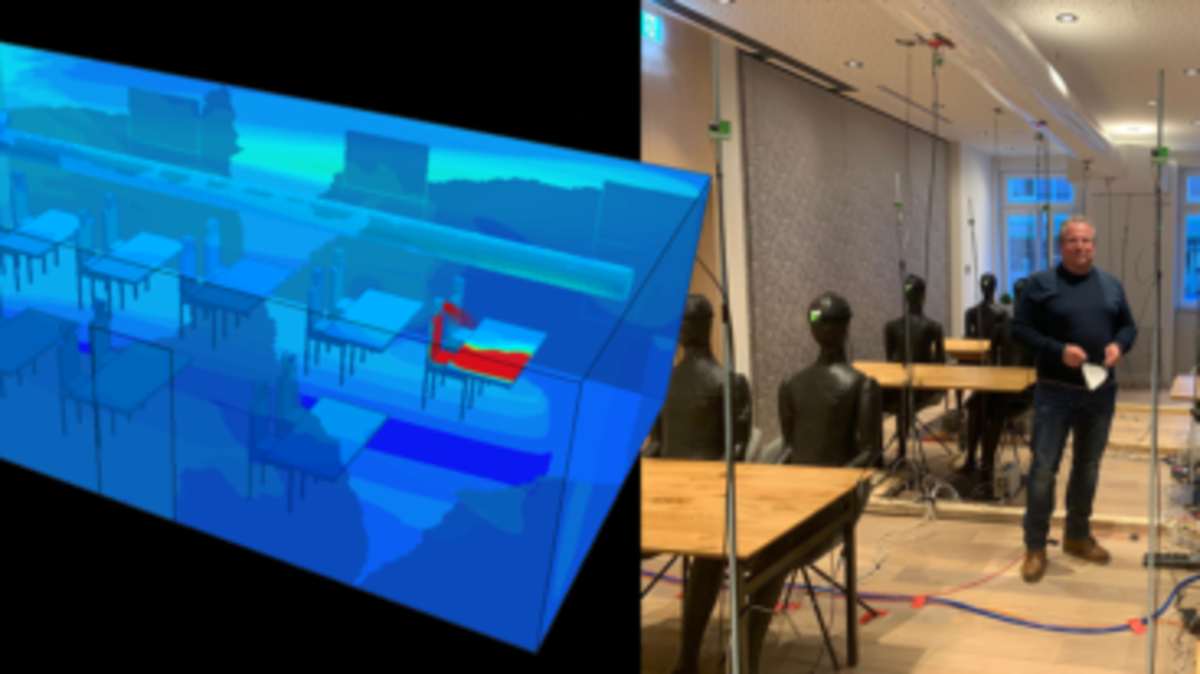Reduce contagion risk without going gaga in shutdown mania

How simulation can help implement meaningful health protection measures
Schools are closed, inns are only allowed to open their outdoor areas, and politicians can't think of too much besides bans.
Personally, I am convinced that the best protection against Corona is still a healthy immune system in conjunction with a healthy diet and physical exercise, but that is just my lay opinion.
If that fits, viruses have worse cards, I think.
As a computational engineer, my question is how viruses are transmitted in principle and what chances we have to reduce our viral load through the use of technology to the point where orderly teaching in schools and universities is possible again.
Also intended as food for thought for those who believe that they automatically become ill when they come into contact with a virus and are allowed to make political decisions whose consequences they do not have to bear.
Let's assume that a short contact is indeed enough to get sick. Let us further assume that the number of viruses with which one comes into contact is decisive (as with poisons, it is the quantity that makes the difference). Since no one can say, even after a year of Corona, from which amount of viruses one gets sick (I also don't believe that this number is onerous, since the individual state of the immune system plays a role in my layman's medical understanding), then one can ask by how much less viruses are buzzing around in the air when using technology.
Since a superspreader (whatever it looks like) exhales breathing air with aerosols full of viruses, the concentration of virused breathing air can be assumed to be 1. For the amount of breathing air you can roughly calculate 12 l/min, actually it is less, between 6-8 liters is given in the literature. But breathing consists of inhaling and exhaling. So if we assume an increased, constant volume flow for the sake of simplicity, it fits.
In a closed room, the virus concentration in the breathing air increases over time. So, in terms of calculation, we have a transient problem. If part of the room air is filtered, the virus concentration is reduced in the filtered air, and ideally all viruses are retained. With good HEPA filters, that almost seems to be the case.
Because it just occurred to me: I don't believe that viruses on escalator belts are killed by 0.1 seconds of irradiation with UV light, we don't get sunburn when we briefly look through the window. But faith helps here, too, and the businessman is happy.
Back to the scenario: Mr. Superspreader, recognizable by the white mask in the opening picture, is now sitting in the room and the question is, who is in his haze circle and how long can he endure the room air without being infected.
However, since we do not know which concentration in the room air is contagious, we proceed comparatively.
We consider once the room without ventilation measures and once with ventilation measures. Then we can at least compare by how many times it gets better or by which factor the concentration gets smaller.
Since the whole thing is a time problem, we considered 16 minutes = 960 seconds in the simulation.
You can see these two scenarios in the attached pictures and videos, respectively.
Video 1 shows the unventilated room.
Video 2 shows the ventilated room, where the room air is filtered by a device that sucks the air through a tube on the ceiling and blows it out cleaned.
In both cases, Mister Superspreader, recognizable by his red bad breath, sits at the front of the classroom.
In a consortium consisting of
| OHB System AG, Oberpfaffenhofen | Clean room, aerospace |
| DLR,Göttingen | Metrology, dolls |
| DLR, Köln | Medicine and microbiology |
| HT Group, Heideck | Clean room, medicine |
| Klinik rechts der Isar, München | Microbiology, Medicine |
| Helmholtz Zentrum München | Virology |
| MERKLE & PARTNER GbR, Heidenheim | Simulation |
measurements were carried out in Hilpoltstein in February 2021, with which we can also match our simulations. This consortium has a concentrated competence to search for technical and scientific solutions for Corona.
We will present the results on the measurements in a joint article in the medium term, when all confidentiality agreements have been signed and Corona is over. Probably in 2024, in spring, after the 17th wave.
But what we can already determine from the simulation side:
The simulation results show that the concentration of viruses in the room air remains almost constant after about 16 minutes when the recirculation system is used, while it is 3 times as high during this period without using the system and continues to increase roughly linearly.
Video 3 shows the direct comparison of both videos.
Conclusion:
It is therefore possible to introduce measures that allow virus concentrations to be kept constant and low by using technology. The only prerequisite is that appropriate filter systems are used, which are in the right place and correctly designed, i.e. from the point of view of fluid mechanics. Of course, we are happy to help with this 😊.
Before our politicians continue to cause billions in damage with shutdowns, it would be cheaper to equip all schools, universities and whatnot with appropriate equipment.
With 32,000 schools in Germany x 12 classrooms, the investment would be about 3 billion euros. The current damage caused by the lockdown per week is many times higher. Ten thousand such systems could be built and installed per month.
Or is a return to the social gathering of people not wanted at all?
But I'd be happy to meet you for a beer even without a corresponding filter situation, then we can discuss the new projects right away 😊
Your Stefan Merkle

PS: The costs alone for the compulsory testing of companies envisaged by Hubertus Heil amount to several billion per month. But money apparently no longer plays a role.